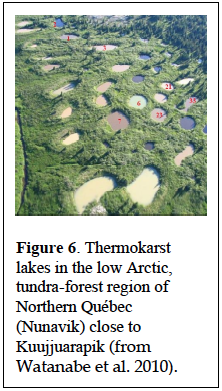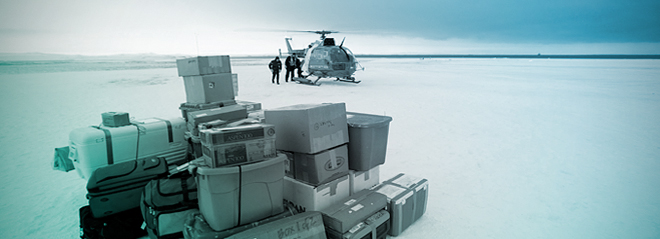|
|

|
|

|
|

|
|
Task 3 - Biogeochemical cycle of metals in permafrost thaw lakes: inventory of phases, species & reactions
Partner in charge: Oleg Pokrovsky (GET-Toulouse, partner 3)
This task aims to document the level and the dispersion of various metals in the permafrost thaw lake environments from Canada and Russia. Samples will be collected during devoted field work and from existing sample banks, if the storage was compatible with the type of analyses performed.
The data obtained in task 3 will be delivered to task 1 (project data base). Results from task 3 will be used to establish a reference scheme for the chemical and isotopic compositions of potential source reservoirs in relation to the exposition of metal contaminants for Northern populations, studied in task 4.
Task 3 comprises 4 sub-tasks according to type of measurements:
- Task 3a - The analyses of major and trace element concentrations in water, suspended matter, sediments
(surface and core), soils, vegetation. Paleo-ecology data from core sediments (O. Pokrovsky; L. Shirokova, S.
Audry; R. Pienitz; post-docs; PhD students; partners engineers).
For more information...
- Task 3b - The analysis of organometal molecules in water and sediments (DMS, DMSe, MeHg), metals
bond to reactive OM, inorganic speciation and bio-availability of metals in soils and sediments by
selective leaching (D. Amouroux; E Tessier; M. Bueno; O. Pokrovsky; C. Cloquet).
For more information...
- Task 3c - Isotopic measurements (C, S, Pb, Hg, Se, Cu, Zn, Ni, Fe) in water, suspended matter, sediments
(surface and core), soils, vegetation (O. Pokrovsky; J. Viers; C. Cloquet; C. France-Lanord; post-docs; PhD students; partners engineers). For more information...
- Task 3d - Modeling the impact of metals on the ecosystem and biodiversity: data synthesis and box/chemodynamic models (O. Pokrovsky; J. Viers; S. Audry; C. Cloquet; C. France-Lanord; D. Amouroux; M. Bueno; E. Tessier; W. Vincent; R. Pienitz; I. Laurion). For more information...
Field work
(O. Pokrovsky; S. Kirpotin; A. Prokushkin; R. Pienitz; D. Amouroux; E. Tessier; M. Bueno;
F. Jorand; post-docs and PhD students)
We selected a number of sites according to their access, physical and chemical characteristics, strategic locations regarding potential metal atmospheric fall out, permafrost state, the knowledge acquired through other studies... In Canada, we selected 2 sites, one in the sub-arctic region of Hudson Bay (Kuujjuarapik) close the tree line at the edge of the boreal forest (N55°15' - sub-arctic climate at these latitude in Eastern Canada). This site is at less than 30 minutes helicopter from the Inuit village where the CEN own and operate a station, equipped with all facilities including a field laboratory. Water from different lakes next to one another has contrasted color (black, brown, beige) testifying of the various limnology and ecosystem regimes (Fig. 6). Also, the water column in many of these lakes is stratified according to dissolved O2, testifying of an important redox gradient, anoxic at the sediment-water interface and oxic at the water-air interface. The second Canadian site is located on Bylot Island, north of the Baffin Island (N 73° 15') in the continuous permafrost. The ponds (2-5 m water depth) are formed on low-center polygons and in runnels over melting ice wedges (or runnel ponds) at the surface of permafrost terrain. A CEN field station close by the pond location is also available to the team project. Permanent meteorological stations are close by these sites and data will be available. Permafrost thaw lakes from these two sites were studied by CEN researchers, including the ones from partner 1 of this project (e.g. Côté et al. 2010; Laurion et al. 2010; Pienitz et al. 2008; Ellis et al. 2008) into which more detailed information can be found. In Siberia, we selected 1 site in Western Siberia, close to the town Nojabrsk located within the forest-tundra zone on discontinuous permafrost terrain; 1 site in Central Siberia close to Tura settlement within the forest zone developed on continuous 100-300 m thick permafrost and, finally, 1 site in Russian Subarctic zone (Arkhangelsk and Nenetsk regions) within the tundra zone on sporadic and discontinuous permafrost. All materials necessary for studies in remote regions, far from equipped scientific stations (tents, rubber boats with motors, electricity generators, small field materials, etc…) were acquired during previous missions in Russia and they are available for work within the present project.

Scientific equipment for field work for on-site measurements (conductimeter, oxymeter, pH-meters with
electrodes, portable voltammetry, temperature and soil humidity sensors, spectrophotometer and
microscope for field work) and for sampling (centrifuge, Ti pressure device for soil solution extraction,
drilling device for sampling of soil and ground ice, pressurized frontal filtration apparatus for collection of
river suspended atter, UV lamp for dissolved organic matter destruction) are available in partners
laboratories. Special efforts will be made for acquiring the equipment necessary for permafrost ice and
lake sediment transport, especially in anoxic conditions, between the field site and the laboratory. The
cryoconservator (Dewar for transport in dry state, adapted for biological samples and containing an
absorbent of liquid nitrogen that allows to keep the samples at -196°C without leaking) has an autonomy
of 21 days for volume of 5 L, it conforms to the norms of aerial transport IATA and ICAO and it will
serve to transport the samples from the site of study to local infrastructures and respective laboratories of
partners. In each site will be collected 1) filtered acidified water (including depth profiles), 2) suspended
matter whenever possible, 3) sediment cores, 4) surrounding soils and vegetation. Specific sampling is
detailed in sub-task 3b.
Risks: Some of the field expeditions might be delayed because of permits that should be delivered by local
authorities in Canada. Up to now, most field work programs of similar project were attributed permits.
Our contacts in both Canadian and Russian Institutions will deal for us and we are very confident. A
number of samples already in hands of our partners from previous studies might replace some samples
planned to collect in the field. Conservation is critical for some analyses we want to perform.





